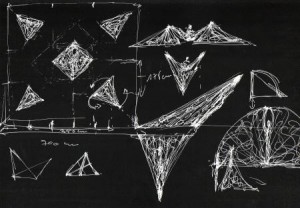Title: “The Rhizome / A Thousand Plateaus”
Author: Gilles Deleuze / Felix Guattari, 1980.

Photo from Faire Rhizome
Deleuze and Guattari introduce the concept of the rhizome as a metaphor for understanding politics, social life, literature, history, and sexuality. A rhizome is “a rootlike subterranean stem, commonly horizontal in position, that usually produces roots below and sends up shoots progressively from the upper surface” (from Dictionary.com, accessed March 16, 2011, based on the Random House Dictionary, Random House 2011). The rhizome “connects any point to any other point” and has “neither beginning nor end, but always a middle from which it grows and which it overspills”. The rhizome morphs, changing in “dimension” and “necessarily… in nature as well.
This is contrasted an “arborial” or tree metaphor which is much more like a hierarchy (roots to trunk to branches to leaves). It is hard to get away from thinking in this more tree-like way, but the rhizome concept forces you to start from the middle, rather than from the bottom or top, and to think in terms of “plateaus” rather than beginnings or endings. The rhizome is made of lines or “lineaments”, but these are not the orderly reporting lines in a “structure” (or hierarchy). As a “plateau is always in the middle, not at the beginning or the end,” a rhizome consists of plateaus. This is a confusing shift of metaphor—to understand this best, do not picture an actual plateau of land but rather the concept of something short of a summit or climax but still other than a beginning or base. The main metaphor is still the rhizome, but the plateau concept essentially means that one is always in the middle, neither at the start nor at some end-stage or goal.
In writing a book as a rhizome, the authors claim that it was written in a non-linear manner; “each plateau can be read starting from anywhere and can be related to any other plateau”. In true interpretive form, the barrier between observer and observed is blurred: “There is no longer a tripartite division between a field of reality (the world) and a field of representation (the book) and a field of subjectivity (the author).” Instead, “an assemblage establishes connections between certain multiplicities drawn from each of these orders”.
Finally, the rhizome is suggested as a model of history, in contrast with a state-centered, hierarchical approach. The state structure reflects “the sedentary point of view”; “What is lacking is a Nomadology, the opposite of history”.

Personal Question:
In this excerpt the authors do not indicate how this rhizome metaphor might be deployed, how an alternative history or “Nomadology” might be written, or what implications the metaphor has more generally. However, it bears a striking similarity to the concept of the network (inspired by the Internet), which has been suggested as an alternative to the hierarchy for organizations. It may be due only to the ingrained metaphor of the pyramid (or the tree, these authors would say) that we find it difficult to imagine other ramifications of the rhizome or network metaphor. What other implications or applications of this metaphor might we identify?
